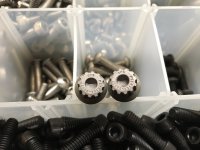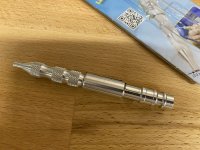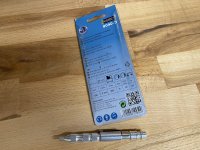I was not familiar with Nitronic stainless steel. Thankfully my good friend, Google, knew all about it.
https://www.hpalloy.com/Alloys/descriptions/NITRONIC60.aspx
It appears that its most valued property is its resistance to galling. That might be the overriding consideration for the propeller shafts. “Galling” is the tendency for stainless steel to weld itself onto tooling when cold worked.
For example, if you wanted to make stainless steel pots or pans (for cooking) you would cold press (stamp, deep draw) the sheets of stainless over a form. The combination of heat generated by the process and and pressure allows the sheet steel to weld minute areas onto the tooling. The result is that additional production would have deep scratches on the surface from the small bits that have welded themselves onto the tooling.
Rotating shafts might also create an environment for galling.
It does not appear that Nitronic is significantly more corrosion resistant that any number of variants of 316 stainless, which I always understood to be the gold standard for corrosion resistance.
But good information to know.
Also, aluminum does “rust”, that is there is created a layer of aluminum oxide, often called “white rust” as it appears as a white powdery substance. Like Corr-ten, it is self-inhibiting. That is once a layer of “rust” develops, no further rust will continue unless you polish away the rust and expose fresh material.
The big complaint about aluminum storm windows and storm doors in the beginning, was the appearance of the white rust. Anodizing the aluminum solved that problem.
With the popularity of 3D printing, I am a bit surprised that amateur investment casting has not followed hard on its heels. Once the 3D printer is obtained, only a furnace that can melt metal (stainless is often used, but investment casting is big in the jewelry industry).
It is also called “lost wax method”, and is a form of sand casting.
The big hit on sand casting, is that the sand mold can crumble so only crude shapes can be made.
With investment casting, the wax “male” is left in place in the sand mold. The molten metal vaporizes the wax and the wax is “lost”. Very precise shapes can be made by this method, though the process is usually limited to fairly small pieces.
I only watched a few minutes of the video below. It shows the method of investment casting. It’s emphasis seems to be jewelry making—that is small pieces. Most stainless steel handguns are made with extensive use of investment casting. Those are the largest pieces I am familiar with that are made by the process.
In the 1980s, AMT made a .380 automatic handgun entirely made from investment cast pieces with no post casting machining. The pieces were used “as cast”, a testament to the precision that method allows.
https://www.hpalloy.com/Alloys/descriptions/NITRONIC60.aspx







